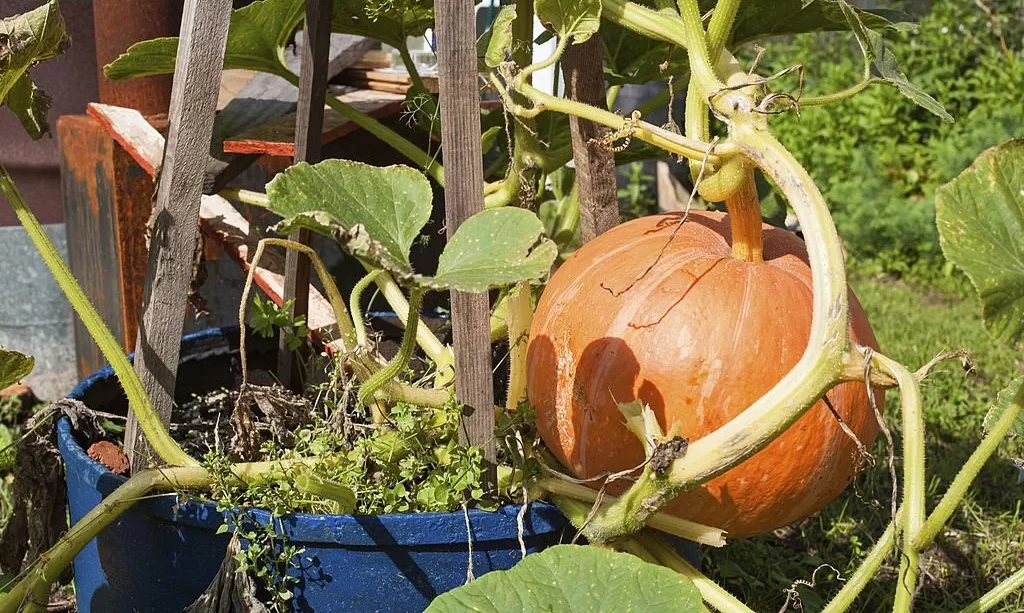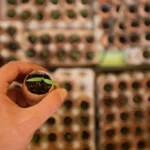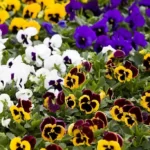Few things evoke the spirit of autumn like a lush pumpkin patch, with plump orange gourds ripe for picking. But what if you have limited garden space or simply want to enjoy the beauty and bounty of pumpkins right on your patio or balcony? The answer lies in the art of growing pumpkins in pots. In this guide, we’ll embark on a journey to discover how you can cultivate these iconic fall favorites in containers, unlocking a world of pumpkin possibilities, even in the coziest of spaces. Whether you’re dreaming of pumpkin pies, seasonal decor, or jack-o’-lanterns, you’ll soon realize that growing pumpkins in pots is not only possible but also incredibly rewarding.
- VARIETIES – Baby Boo, Sugar Pie, Jack O Lantern, Jack Be Little, Giant Big Max Pumpkin Seeds for Planting.
- OUTDOOR GARDEN – Fun vegetable perfect for your outdoor garden. Seeds can be sown directly into the garden.
- TASTY AND PRETTY – There’s nothing more satisfying than growing your own giant pumpkin, or small baby boo pumpkins.
- SUMMER / FALL – Pumpkins are grown in the summer and enjoyed throughout the fall and winter months.
- USA – All of our non-GMO, heirloom pumpkin seeds for planting were grown, harvested and packaged in the USA.
Choosing the Right Pumpkin Variety
Growing pumpkins in pots begins with the essential step of selecting the perfect pumpkin variety. Here’s what you need to consider:
- Size Matters: Determine the size of the pumpkins you want to grow. Different pumpkin varieties range from small pie pumpkins to large jack-o’-lantern types. Consider your available space and your intended use for the pumpkins when making your choice.
- Growing Season: Check the average number of days to maturity for the pumpkin variety you’re interested in. Shorter growing seasons are ideal for regions with cooler fall weather or for late-season planting in containers.
- Climbing vs. Bush Varieties: Some pumpkin varieties have a more compact, bushy growth habit, while others are climbers with long vines. Choose a variety that suits the size of your container and your space.
Selecting the Perfect Container
The container you choose for your pumpkin plants plays a crucial role in their success:
- Size and Depth: Pumpkins have extensive root systems and require ample space to grow. Select large containers with a minimum volume of 15-20 gallons (57-76 liters) to provide enough room for the roots to spread. Depth is also crucial; containers should be at least 18-24 inches (45-60 cm) deep.
- Material: Containers made of sturdy materials like plastic, ceramic, or fabric work well for pumpkins. Ensure that the container is food-safe if you plan to grow edible pumpkins.
- Drainage: Proper drainage is essential to prevent waterlogged soil, which can harm the plants. Choose a container with drainage holes at the bottom to allow excess water to escape.
- Stability: Pumpkins can become heavy as they grow and bear fruit. Choose a container that can support the weight of the plant and fruit without toppling over.
By carefully selecting the right pumpkin variety and choosing a container that meets the plant’s needs, you’ll set the foundation for a successful pumpkin-growing adventure in pots. In the sections to follow, we’ll delve deeper into soil and growing conditions, planting and maintenance, and the thrilling prospect of harvesting your homegrown pumpkins, transforming your small garden space into a festive pumpkin haven.
Soil and Growing Conditions
To create an optimal environment for your container-grown pumpkins, pay attention to soil and growing conditions:
- Well-Draining Soil: Choose a high-quality potting mix that provides excellent drainage. Pumpkins dislike having their roots sitting in waterlogged soil, which can lead to root rot. A mix designed for vegetables or containers is ideal.
- Nutrient-Rich Soil: Pumpkins are heavy feeders, so amend your potting mix with compost or well-rotted organic matter to ensure an adequate supply of nutrients. This is especially important as they grow and produce fruit.
- Sunlight: Pumpkins thrive in full sun. Ensure that your containers receive at least 6-8 hours of direct sunlight daily. If your space doesn’t provide this, consider using a container with wheels to move the pumpkin plant to sunnier spots during the day.
- 100% Natural & Organic Fertilizer Contains NO GMOs (Genetically Modified Organisms)
- Super Concentrated Slow Release – feeds plants and soil over time Treats up to 100 sq ft or 28 1-gallon plants up to 4 months.
- Improves Plant Growth Will not burn plants ( when used as directed )
- 6-2-3 Organic Fertilizer With 25% WOW Mycorrhizae plus Kelp & Humates For use in soil amending, transplanting, and established plants 100% Natural and Organic
- Contains Mycorrhizae for explosive root growth Contains WOW Mycorrhizae,At Least 85,000 Microbes Inside 2.2 lb Bag. Increases absorption of nutrients and water
Planting and Maintenance
Successful pumpkin growing in containers involves the following planting and maintenance considerations:
- Planting Depth and Spacing: When planting pumpkin seeds or seedlings in your container, make sure they are placed at the same depth as they were in their original containers. Space multiple plants at least 2-3 feet (61-91 cm) apart in the container to prevent overcrowding.
- Watering: Keep the soil consistently moist, but not waterlogged. Container-grown pumpkins may require more frequent watering, especially in hot weather. Water at the base of the plant to avoid wetting the leaves, which can lead to disease.
- Fertilization: Pumpkins are heavy feeders, so they benefit from regular feeding. Use a balanced, slow-release fertilizer or apply a water-soluble fertilizer according to the package instructions. Start fertilizing when the plants begin to vine and continue throughout the growing season.
- Support and Pruning: As your pumpkin vines grow, provide support for the developing fruit using slings or hammocks to prevent damage to the vines. Prune away excess foliage to improve air circulation and sunlight penetration to the developing fruit.
- STIMULATE & ACCELERATE: An acidic foliar fertilizer that feed through roots and leaves which contains a blend of plant growth stimulants and other nutrients designed to accelerate plant growth and improve yields
- MICRO-NUTRIENTS: Contains micro-nutrients and vitamins plants need
- HIGH CONCENTRATE: 1-2 oz per gallon of water; makes up to 32 gallons of fertilizer
- GUARANTEED ANALYSIS: 11% Nitrogen | 8% Phosphorus | 5% Potassium with .02% Boron .1% Iron .05% Manganese .05% Zinc
- MEASURE & POUR: Comes in an easy measure and pour bottle that allows the end-user to measure and pour a specific dosage by simply squeezing the bottle. See images for directions.
Pollination and Fruit Set
Successful fruit development is a key goal when growing pumpkins in containers:
- Natural Pollinators: Pumpkins rely on pollinators like bees to transfer pollen from male to female flowers. Ensure that your garden attracts pollinators by planting pollinator-friendly flowers nearby.
- Hand-Pollination: To increase the chances of successful fruit set, you can hand-pollinate pumpkin flowers. Use a small brush or cotton swab to transfer pollen from male flowers to female flowers.
- Identifying Female Flowers: Female pumpkin flowers have a tiny fruit at their base, while male flowers have a straight stem without fruit. Focus your pollination efforts on the female flowers to ensure fruit development.
By addressing soil and growing conditions, planting and maintaining your pumpkin plants with care, and facilitating pollination, you’ll set the stage for healthy growth and the promise of delicious homegrown pumpkins in your container garden.
Overcoming Container Challenges
Container gardening, while rewarding, can present unique challenges when growing pumpkins. Here’s how to overcome them:
- Space Management: Pumpkins have sprawling vines that can take up a lot of room. To maximize space, consider using vertical supports or trellises to train the vines to grow upward. This allows you to make the most of your container’s vertical space.
- Watering Care: Containers can dry out quickly, especially in hot weather. Use mulch to retain moisture in the soil and water consistently to prevent stress on the plants. Self-watering containers can also be a helpful solution.
- Fertilization: Container-grown pumpkins rely on you for nutrients. Monitor the plant’s growth and adjust your fertilization schedule as needed to ensure they receive sufficient nutrients throughout the growing season.
- Temperature Control: Containers are more susceptible to temperature fluctuations. Protect your pumpkin plants from extreme heat by providing shade during scorching days and moving them to a sheltered spot during cold snaps.
Harvesting Your Container Pumpkins
The culmination of your container pumpkin growing journey is the eagerly awaited harvest:
- Ripeness Signs: To determine when to harvest, look for signs of ripeness. Pumpkins should have vibrant color, a hard skin, and a hollow sound when you tap them. The stem should also start to dry and turn brown.
- Cutting Technique: Use clean, sharp shears or a knife to cut the stem of the pumpkin, leaving a few inches of stem attached to the fruit. Be gentle to avoid damaging the fruit.
- Enjoying Your Homegrown Pumpkins: Once harvested, savor the rewards of your container-grown pumpkins. Whether you use them for pies, carving, or decorative displays, your efforts have yielded the joys of the fall season right on your doorstep.
Conclusion
Growing pumpkins in containers brings the joy of autumn to even the smallest of spaces. By carefully selecting the right variety, choosing suitable containers, and providing the ideal growing conditions, you can nurture these iconic fall favorites to maturity. Throughout the growing season, attentive care, pollination support, and overcoming container gardening challenges contribute to the success of your pumpkin plants.
As you enjoy the vibrant colors and delicious flavors of your homegrown pumpkins, you’ll find that the effort and patience invested in container gardening have yielded a bountiful harvest and a sense of accomplishment. Whether you’re decorating your space with festive pumpkins or baking pies for family gatherings, container-grown pumpkins prove that big autumn delights can thrive in compact spaces, making every fall season a memorable one.







